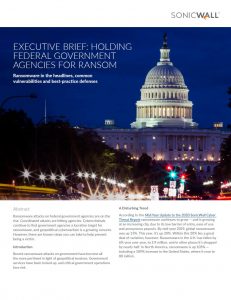Enjoy the Speed and Safety of TLS 1.3 Support
SonicWall NGFWs offer full TLS 1.3 support — ensuring your network can handle the latest encryption protocols.
by Amber Wolff

The best products tend to stick around for a while. In the first two years that the Ford Mustang was manufactured, 1965 and 1966, roughly 1.3 million cars rolled off assembly lines in Dearborn, Mich.; Metuchen, N.J.; and Milpitas, Calif. Of those, a remarkable 350,000 are still on the road today — and with proper care, still getting from Point A to Point B just as well as they did during the Johnson Administration.
But aesthetics aside, does that make them a good choice for a daily driver today? In a crash test with any modern vehicle (or a race with any of today’s Mustangs), the first-generation Mustang would be completely overwhelmed. Safety features we take for granted, such as airbags, lane-keep assist, blind spot detection and anti-lock brakes, are absent. These cars might do fine for the occasional Sunday spin around town. But would you put your family in one?
When a product forms the boundary between something precious and grave disaster, you want that product to be as safe as possible. This also holds true for another Milpitas innovation: SonicWall firewalls. To know whether your current choice is still the right choice, it helps to look at what innovations have occurred since then, and whether they were incremental improvements or giant leaps forward. In the case of TLS 1.3 encryption support, it’s unquestionably the latter.
TLS 1.3 is the latest version of transport layer security, which offers reliable encryption for digital communications over the internet. And as with the Mustang before it, modern innovations have led to sizeable leaps in two areas: safety and performance.
TLS 1.3: Safety First
Since the original SSL technology was introduced in 1994, each new version has worked to solve the problems of the previous versions while also maintaining compatibility with those versions. But, unfortunately, maintaining backward compatibility meant leaving in many unnecessary or vulnerable ciphers.
These legacy ciphers made the encryption susceptible to attack, offering attackers a vector through which to circumvent newer security advances in favor of older and weaker protection. A few of the ciphers that persisted up through TLS 1.2 were so weak that they allow an attacker to decrypt the data’s contents without having the key.
TLS 1.3 represents a fundamental shift in this philosophy. Due to a sharp increase in attacks, such as Lucky13, BEAST, POODLE, Logjam and FREAK, which depend on such vulnerabilities for transmission, the Internet Engineering Task Force (IETF) opted to remove these ciphers altogether — and the resulting TLS 1.3 is vastly more secure because of it.
It’s also more private. In previous versions, including 1.2, digital signatures weren’t used to ensure a handshake’s integrity — they only protected the part of the handshake after the cipher-suite negotiation, allowing attackers to manipulate the negotiation and access the entire conversation.
In TLS 1.3, the entire handshake is encrypted, and only the sender and the recipient can decrypt the traffic. This not only makes it virtually impossible for outsiders to eavesdrop on client/server communications and much harder for attackers to launch man-in-the-middle attacks, it also protects existing communications even if future communications are compromised.
TLS 1.3: Safety Fast
With TLS 1.3, the handshake process isn’t just more secure — it’s faster, too. The four-step handshake required with TLS 1.2 necessitated two round-trip exchanges between systems, introducing latency and taking up bandwidth and power.
These slowdowns especially affected the growing class of Internet of Things (IoT) devices, which have trouble handling connections requiring lots of bandwidth or power, but also tend to need encryption most due to weak onboard security.
However, with just a single key exchange and significantly fewer supported ciphers, TLS 1.3 uses considerably less bandwidth. And because it requires just one round trip to complete the handshake, it’s significantly faster. TLS 1.3’s zero round trip time (0-RTT) feature is even quicker: On subsequent visits, it offers a latency time equal to that of unencrypted HTTP.
Is Your Firewall Up to the Task?
Experts estimate that 80-90% of all network traffic today is encrypted. But many legacy firewalls lack the capability or processing power to detect, inspect and mitigate cyberattacks sent via HTTPs traffic at all, let alone using TLS 1.3 — making this a highly successful avenue for hackers to deploy and execute malware.
According to the 2022 SonicWall Cyber Threat Report, from 2020 to 2021, malware sent over HTTPS rose a staggering 167%. All told, SonicWall recorded 10.1 million encrypted attacks in 2021 — almost as many as in 2018, 2019 and 2020 combined.
With an average of 7% of customers seeing an encrypted attack in a given month, the odds your organization will be targeted by an attack this year are enormous. But if your firewall cannot inspect encrypted traffic — and increasingly, if it cannot inspect TLS 1.3 — you’ll never know it until it’s too late.
SonicWall Supports TLS 1.3 Encryption
SonicWall Gen 7 firewalls bring a lot to the table: They combine higher port density and greater threat throughput with comprehensive malware analysis, unmatched simplicity and industry-leading performance. But among the biggest game-changers in Gen 7 (and its predecessors capable of running SonicOS Gen 6.5) is its support for TLS 1.3 encryption.
SonicWall NGFWs with SonicOS Gen 6.5 and later offer full TLS inspection, decrypting data, checking it for potential threats, and then re-encrypting it for secure transmission — all while ensuring you retain optimal performance and comprehensive visibility.
After all, as in the case of the classic Mustang, there’s no blind spot detection for firewalls that can’t handle today’s encrypted traffic — and these legacy solutions are easily outclassed when going head-to-head. Don’t let yesterday’s firewalls leave unprotected gaps in your network: Upgrade to SonicWall Gen 7 today.
Share This Article

An Article By
An Article By
Amber Wolff
Amber Wolff





